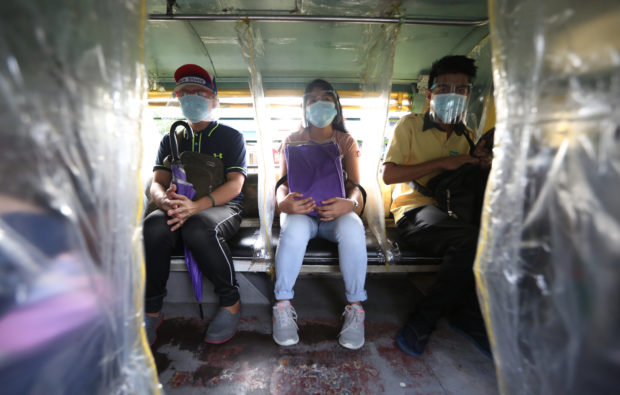
INQUIRER file photo / NIÑO JESUS ORBETA
MANILA, Philippines — The curfew in Metro Manila from midnight to 4 a.m. will be lifted starting Nov. 4, the same day that the increase in passenger capacity of public utility vehicles (PUVs) will be implemented.
The easing followed the improving healthcare system and the continued decline in COVID-19 cases, with the Department of Health (DOH) reporting on Wednesday 1,591 new cases, the country’s lowest daily infections in nearly nine months.
It was the lowest since Feb. 24 when 1,557 new infections were recorded in a single day.
Chair Benhur Abalos of the Metropolitan Manila Development Authority (MMDA) said during a meeting with President Duterte on Tuesday night that the curfew
lifting would resolve mall operators’ concerns on limited public transport and the impact of a curfew on their longer operating hours ending at 11 p.m.
Under MMDA Resolution No. 21-25, lifting the curfew in Metro Manila would “provide both mall goers and mall employees ample time to get home.”
Abalos said the mayors believed this would also reduce the risk of virus transmission.
However, he said during the President’s televised address aired on Wednesday morning that the lifting was “subject to existing ordinances (imposing) curfew hours for persons below 18 years of age and the continued observance and enforcement of COVID-19 protocols and minimum health standards.”
Mall operators in Metro Manila earlier agreed to lengthen their operating hours to absorb the expected influx of shoppers during the Christmas season.
However, they were worried that the curfew at midnight would affect their employees going home for the day due to the limited capacity of public transport.
The Inter-Agency Task Force for the Management of Emerging Infectious Diseases (IATF) recently approved the increase in PUV capacity to 70 percent from 50 percent to help address the commuting problem.
Transport guidelines
The Land Transportation Franchising and Regulatory Board (LTFRB) on Wednesday released the guidelines for the increased capacity for rail lines and PUVs operating in Metro Manila and its adjacent provinces.
Under LTFRB Memorandum Circular No. 2021-064, only public utility buses (PUBs), public utility jeepneys (PUJs) and UV Express in Metro Manila, Laguna, Rizal, Cavite and Bulacan “may operate under the approved passenger capacity as a result of the continuous decline in COVID-19 infections and government’s aggressive COVID-19 vaccination rollout” in these areas.
In limiting the new policy to Metro Manila and nearby provinces, LTFRB Chair Martin Delgra said they considered the people from the nearby provinces who commute to and from Metro Manila.
The LTFRB expects the new policy to help distressed public transport workers increase their income amid the pandemic and rising oil prices.
Mark Steven Pastor, assistant secretary for road transport and infrastructure, said the Department of Transportation would observe the first three days of implementation of the 70-percent capacity rule in PUVs before recommending a further increase to 100 percent.
Seating plan
In its memorandum, the LTFRB prescribed seating design plans at 70-percent capacity for different types of buses, jeepneys and UV Express.
For coach-type buses with 2 by 2 seating arrangement, a maximum of 34 passengers are allowed inside, while 43 passengers are allowed in 2 by 3 coach-type buses.
Low-entry 2 by 2 buses, which can carry as many as 39 passengers, can now carry up to 27 passengers.
While the LTFRB earlier announced that standing passengers would be allowed inside PUBs once the 70-percent capacity rule took effect, Delgra said they had to revise this earlier recommendation to develop a maximum seating capacity plan for road-based transport.
Class II modern PUJs and class III units can now carry a maximum of 13 passengers. Traditional PUJs may carry up to 11 passengers.
New cases
The railway sector, including LRT 1, LRT 2, MRT 3 and Philippine National Railways, will also implement the increase in passenger capacity from the current 30 percent to 70 percent starting Nov. 4.
The latest fresh case tally pushed the total number of cases to 2,793,898.
However, the DOH said seven laboratories failed to submit their data.
In an online briefing on Wednesday, Health Secretary Francisco Duque III said the downtrend would continue only if Filipinos remained “careful and do not squander the gains we have achieved.”
Active cases, or those currently sick with COVID-19, also fell to an eight-month low to 38,014.
There were 4,294 additional recoveries, bringing the total to 2,712,298. The country’s death toll stood at 43,586 after 186 more patients succumbed to the disease.
The positivity rate was at 5.6 percent after 1,651 were found positive out of the 29,489 tests conducted.